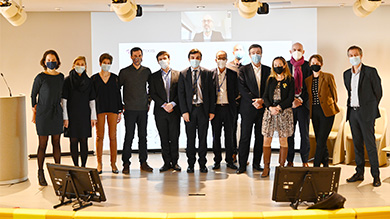The Covid-19 epidemic has shown the effectiveness of home-working and has disrupted traditional work methods, accelerating the deployment of remote working.
Will this lead to a downward trend on the office market? Thibaut Cuilliere, Head of Energy & Real Assets Research, Natixis, analyzes the various factors and reveals the results of a case study on the Paris region in this podcast:
Click on the visual to listen to the podcast.
The Covid-19 outbreak has led to structural changes in the way we work. It has turned the traditional way of working upside down and meant forced remote working in many companies. Many employees therefore had to work from home during the lockdown period, but this crisis actually showed that staff were able to do so efficiently without jeopardizing the collective outcome. Therefore, we think post Covid-19, remote working will accelerate substantially and will have some consequences on office spaces.
However, just as e-commerce has not killed physical retail, we do not expect remote working and home office to kill physical office space either, for three reasons:
- Firstly, new health measures are very likely to implemented in offices following the lessons learnt from the Covid-19 epidemic. Social distancing and new types of collaborative environments will lead to a substantial increase in footprint size, all things being equal;
- Secondly, the structural trend for workplace wellness will be reinforced by the Covid-19 crisis and goes against the trend for more dense office spaces seen previously;
- Thirdly, although working from home has clearly proved to have a lot of benefits during the lockdown period, it does not mean that 100% remote working is optimal for companies. In particular, too much remote working leads to limited social interactions and loneliness for employees. It also dampens creativity and innovative thinking, while it can create a real challenge for developing and maintaining corporate culture.
We carried out a case study on the Paris region office market. We assumed that 55% of the workforce would work remotely at least 2 days per week in 10 years’ time, compared with 13-15% before Covid-19. We also assumed that health measures and wellness trends would lead to an increase of around 4 square meters per employee. We then simulated the impact of the economic crisis, remote working and health and wellness trends on vacancy spaces in the Paris region, assuming that these factors would impact office spaces whenever a building is created or a lease contract is renewed.
Following this analysis, we believe that the vacancy rate in the Paris region will increase by 3 points by the end of 2021, but most of it will be due to the economic effects from the Covid-19 crisis and not from remote working. In 10 years’ time, we expect the vacancy rate to rise by 3 points from the current level, although health & wellness trends will offset 80% of the impact stemming from remote working.
This will translate into an average 10% drop in the capital value for offices in the Paris region in 10 years. The impact of remote working will actually be much more moderate that one might think, given that capital values dropped by 30% to 35% during the previous downturns in 2001-2003 and 2008-2009.
The effect of remote working should not overshadow long-term supporting factors for office valuations. Firstly, the yield premium offered by offices vs fixed-income instruments appears all the more attractive as liquidity proved to be an issue for traditional liquid assets during the month of March 2020. Secondly, public institutions and notably pension funds will continue to increase the presence of real assets in their portfolios, and that will benefit offices.
Finally, there will be some winners and losers. We believe that post-Covid demand for office spaces will focus on buildings’ flexibility, modernity, sustainability and environmental features, as well as high safety standards. Locations close to transportation hubs will be sought after, while central locations will remain core for premium corporates.















